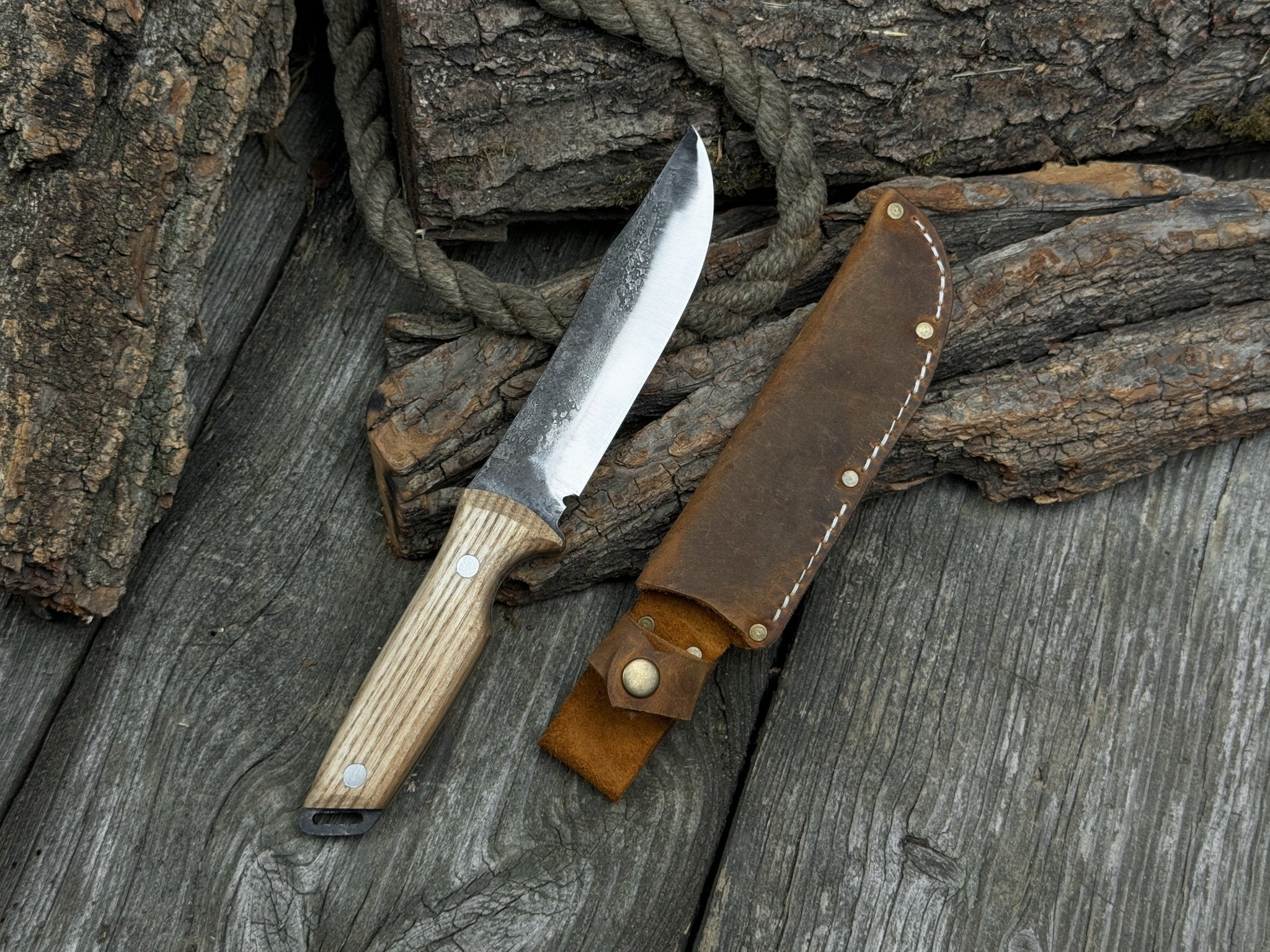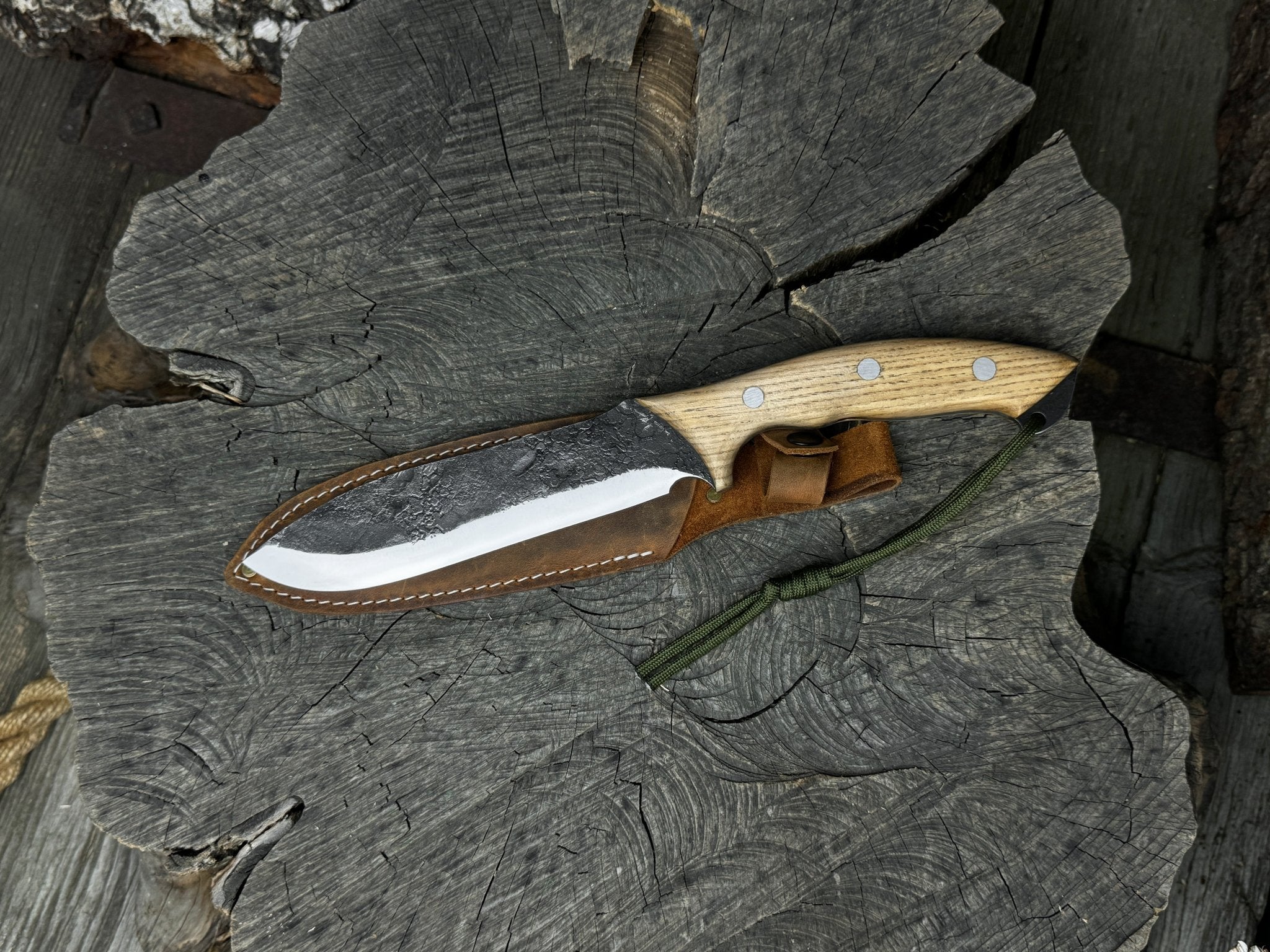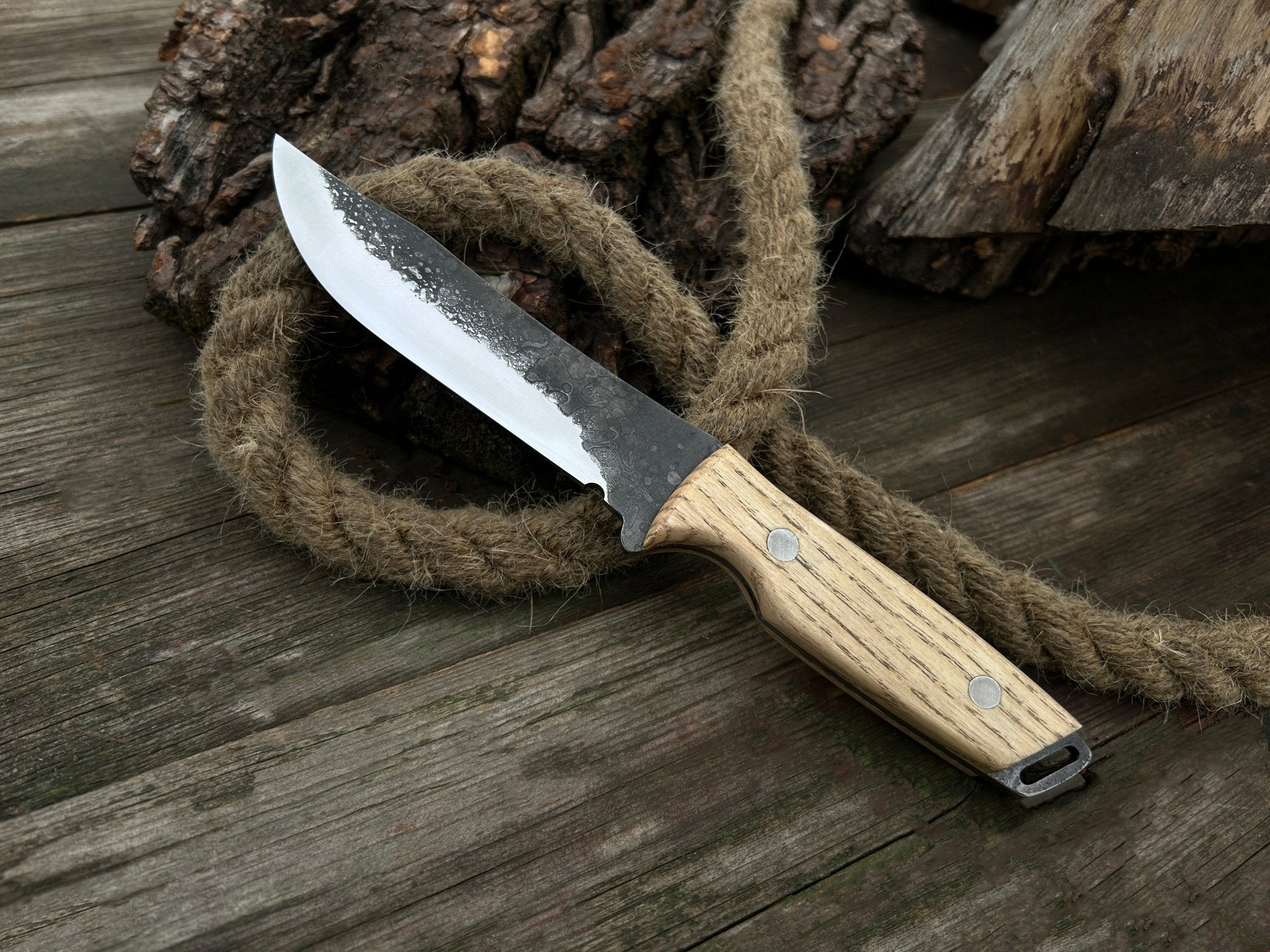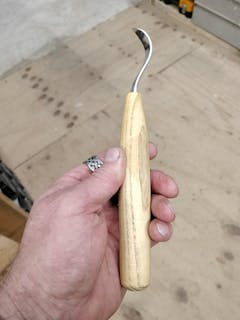Hand-Forged Bushcraft Knife, 12 cm (4.72 inches)
Hand-Forged Bushcraft Knife, 17 cm (6.7 inches) with leather sheath
Hand-Forged Camping (Chopping) Axe, 0.6 kg (1.32 Ibs)
Hand-Forged Bushcraft Knife, 15.5 cm (6.1 inches)
Hand-Forged Yakut Knife with Leather Sheath, 9.5 cm (3.74 inches)
Hand-Forged Bushcraft Knife, 12 cm (4.72 inches)

Hand-Forged Small Camping Axe with Curved Handle, 0.52 kg (1.15 Ibs)
Hand-Forged Bushcraft Knife, 20.5 cm (8.07 inches)
Hand-Forged Bushcraft Knife, 10 cm (3.9 in) Blade with Leather Sheath
Hand-Forged Camping Knife, 12.5 cm (4.9 inches)
Hand-Forged Bushcraft Knife, 27 cm (10.6 inches)
Understanding Bushcraft: The Essential Tools for Wilderness Survival
What is Bushcraft?
Bushcraft is the knowledge and skill of living outdoors. It has gained popularity recently as a way to disconnect from technology, practice a sustainable lifestyle, and develop self-reliance.
Unlike outdoor survival, which focuses mainly on overcoming environmental challenges, bushcraft is more about working with nature in tandem to live comfortably and sustainably.
Essential bushcraft gear includes bush tools and survival gear such as an axe for chopping wood, a knife for various tasks, a whetstone for sharpening blades, a compass for navigation, and a fire starter. These tools help perform basic bushcraft activities like building shelters, making fires, and foraging for food.
Why the Right Gear is Crucial for Bushcraft?
Selecting the right bushcraft survival gear is highly personal, depending on one’s environment, body type, skill level, and preferences. Therefore, any recommended bushcraft tools are suggestions based on the shared experience of bushcrafters.
Many people choose gear based on functionality and personal comfort rather than strict survival needs. For that reason, some avoid heavy traditional items like wool blankets and canvas tarps, opting instead for modern, lightweight options that make adventure hiking and bushcrafting more enjoyable.
Compact, lightweight bushcraft tools and camping accessories, like a pocket fishing kit, add flexibility and help avoid unnecessary bulk.
Selecting the best bushcraft tools for your adventure is also crucial because:
- Proper bush tools can help prepare for unexpected weather and can assist in signaling for help during emergencies.
- Quality gear enhances the experience, letting you focus on building bushcraft skills.
- It enables you to cook food, start fires, carve wood, and build shelters more efficiently.
- Durable, versatile gear is less likely to fail in critical situations, adapts to different tasks, and increases your survival chances while keeping your load lighter.
If you also value compact bushcraft gear that emphasizes functionality, accessibility, and simplicity, here are some recommendations:
First Aid & Essentials: A first-aid kit should be readily accessible. A radio is helpful for group trips, and a GPS is useful in less familiar terrain.
Tools: Key bushcraft supplies include a saw, bushcraft knife, and bushcraft axe for tasks like preparing food, making feather sticks for fires, splitting logs, and building shelters. Working gloves and a small folding saw can assist with wood gathering and camp setup.
Backpack Structure: A durable, water-resistant canvas pack with extra waxing on the bottom for waterproofing.
Shelter & Comfort:
- Tarp and Bivvy Bag: A 3x3 tarp and a waterproof bivvy bag offer versatile shelter options.
- Sleeping Pad & Mat: A sleeping pad is essential, and an old foam mat adds protection for the tarp against sticks.
- DIY Chair: A portable chair setup and compact sit pad add camp comfort.
Clothing:
- Layers: Only essential clothing, such as a fleece layer, waterproof jacket, socks, and thermal underwear.
- Waterproof Storage: Waterproof sacks keep clothes and sleeping gear dry in all conditions.
Cooking System:
- Compact Cooking Kit: Includes a titanium pot, mug with lid, and frying pan.
- Eating Utensils: A spork and a Swiss knife.
Fire Kit & Possible Pouch:
- Fire-starting Tools: Birch bark, a tin for char cloth, a magnifying glass, and a fire rod for traditional fire-starting.
- Sharpener: For knife and axe maintenance.
- Natural Cord: Eco-friendly cord.
Other Gear:
- Sling for Hunting: For small game if needed.
Key Bushcraft Tools You Need for Outdoor Survival
Bushcraft Axes
Bushcraft axes are essential bushcraft tools, indispensable for felling trees, crafting tools, and splitting wood. Unlike large forestry axes, these wilderness tools are often more compact, lighter, and suited for precision work.
Smaller, lighter axes are better suited for fine woodworking and crafting, while larger, heavier axes handle heavy-duty tasks like felling large trees and splitting wood. Common types include:
- General-Purpose Bushcraft Axe: A multi tool with a medium-sized head and 20-inch handle, suitable for both carving and chopping.
- Tomahawk: A straight-handled, lightweight axe with a small head, used for wood carving or as a backup tool.
- Small Forest Axe: A balanced design for versatile tasks, from chopping firewood to shaping timber for shelter.
- Scandinavian Forest Axe: Heavy-duty with a longer handle and wider cutting edge, ideal for serious bushcraft tasks like felling large trees.
Bushcraft Knives
Choosing the right bushcraft supplies depends on your goals and needs. Here are some variations and their differences:
Blade Design
- Scandinavian Grind: Most popular, easy-to-maintain grind for carving.
- Full Flat Grind: Versatile edge for slicing and general use.
- Convex Grind: Durable edge for heavy-duty tasks.
Blade Length
- Short: Perfect for detailed work, feathering sticks, and skinning. The length ranges from 3 to 4 inches.
- Medium: Can be used for food prep or even chopping. The blade length is between 4-6 inches.
- Large: Useful for batoning and other heavy-duty tasks. The length of the blade is usually 6 inches and more.
- Blade Material: Carbon steel offers excellent edge retention; stainless steel resists corrosion.
- Tang Type: Full tang provides strength, while partial tang is common in lighter folding knives. It is usually lighter, but may not be as durable as a full tang.
- Handle Material: Wood provides a comfortable grip; rubber handles are weather-resistant.
- Additional Features: Finger guards enhance safety and grip stability.
Factors to Consider When Choosing an Axe
To ensure you have the right bushcraft camping gear at hand, here are a few factors you may want to think of first:
- Purpose: Identify whether it’s for chopping, carving, or a mix of tasks.
- Size and Weight: Choose an axe you can comfortably carry and wield over long distances.
- Handle Material: Wooden handles require care, while synthetic materials offer weather resistance.
- Quality of Head Steel: High-carbon steel, known for edge retention, is often recommended for bushcraft axes as it stays sharp for longer periods of time.
What to Look for in a Bushcraft Knife
When selecting bushcraft woodworking tools, like knives, consider:
- Purpose: General bushcraft, hunting, or specific tasks.
- Blade Shape: Choose a shape that suits your needs, e.g., drop-point for versatility, clip-point for piercing.
- Blade Material: Stainless steel for corrosion resistance, or carbon/high carbon steel for edge retention.
- Handle Material: Prioritize a grip-friendly material.
- Weight and Size: Balance portability and functionality based on your specific needs.
- Sharpening: Select a knife that's easy to maintain in the field.
Maintaining and Caring for Your Bushcraft Gear
Axe Care Tips
Proper maintenance of bushcraft survival tools, especially axes, is crucial for their longevity and effectiveness. Clean and thoroughly dry your axe after each use to prevent rust. Regularly inspect the handle, applying boiled linseed oil if needed to preserve the wood. Use a sharpening stone or file to maintain the edge and check the bevel for optimal performance.
Knife Maintenance Essentials
Keep your bushcraft woodworking tools clean and dry at all times. Since you do not have access to the full sharpening kit in the woods, there are some effective, compact sharpeners you may use on the go:
- Diamond-Coated Sharpeners: These small tools feature diamond-coated rods that can quickly refine a blade's edge of your wilderness tools.
- Ceramic Rod Sharpeners: Similar to diamond-coated sharpeners, ceramic rods offer a fine grit for honing the edge.
Shop Our Wood Carving Chisel Sets Today
Sharky Forged Steel Tools™ offers 100% handmade bushcraft tools ready to use out of the box. Our selection of bushcraft supplies includes knives and axes suitable for multipurpose uses.
We provide worldwide shipping with tracking, ensuring that your delivery day is hassle-free. Plus, with our refund and exchange policies, you can shop with confidence.
Among the offerings we provide, you will find bushcraft knives with both straight and curved blade shapes, available in various sizes. Our knives range in blade length from 7 cm (2.8 inches) to 30 cm (11.81 inches) and handle lengths from 11 cm (4.3 inches) to 12 cm (4.72 inches), with weights between 70 g (2.5 oz) and 500 g (17.64 oz). Each knife comes pre-sharpened and includes a leather sheath to protect the blade. These best tools are designed to meet the diverse needs of bushcrafters, making them an essential part of your gear.
The bushcraft axes can be used for chopping or splitting firewood, crafting camp utensils, trail clearing, and other general bushcraft work. The axes feature blade lengths from 9 cm (3.54 inches) to 10 cm (3.94 inches), head lengths of 15 cm (5.91 inches), and weights between 0.52 kg (1.15 lbs) and 0.6 kg (1.32 lbs).
Made from 52100 carbon steel (59/62 HRC), the tools offer best-in-class edge retention and wear resistance.
With our bushcraft tools, you will be well-equipped for any wilderness challenge!





























